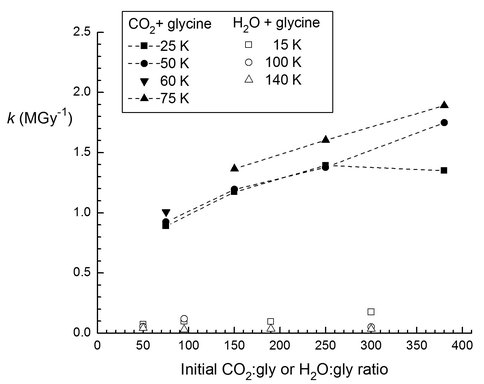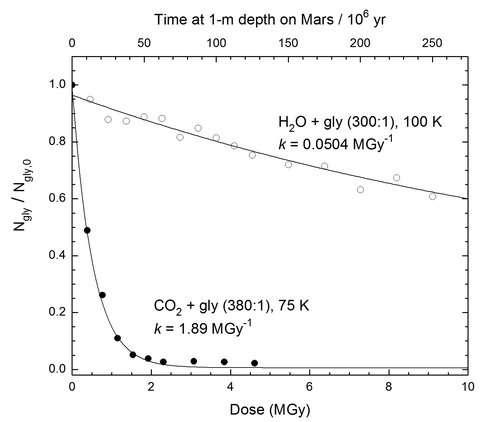2014 Annual Science Report
 NASA Goddard Space Flight Center
Reporting | SEP 2013 – DEC 2014
NASA Goddard Space Flight Center
Reporting | SEP 2013 – DEC 2014
Laboratory Investigations Into Chemical Evolution in Icy Solids From the Interstellar Medium to the Outer Solar System to Meteorites
Project Summary
NAI-GCA support in 2014 helped us continue our work on amino-acid stability. In 2014, we performed radiation experiments to measure the destruction rate of glycine in CO2 ice. In particular, we found that this rate depends on concentration and temperature, and is 20-40 times greater than for glycine in H2O-ice.
Project Progress
NAI-GCA support in 2014 helped us continue our work on amino-acid stability. In 2014, we performed radiation experiments to measure the destruction rate of glycine in CO2 ice. In particular, we found that this rate depends on concentration and temperature, and is 20-40 times greater than for glycine in H2O-ice. These results imply that glycine at a subsurface depth of 5-10 meters embedded in CO2-ice on Mars would not survive more than 100 million years, but could survive for 2-4 Gyr if stored in H2O-ice. This work recently was accepted for publication in Icarus.
In addition to our glycine project, we also have extended last year’s IR study of optical constants and band strengths of ices, this time for the three C2 hydrocarbons (C2H2, C2H4, C2H6) as part of our interest in the carbon inventory of the outer Solar System.
In a collaboration with the Astrobiology Analytical Laboratory we have initiated a new project designed to understand heterocycle chemistry in meteorites. Our first molecular targets are nicotinic acid and its isomers. A related paper has been published and a second is in preparation for an early 2015 submission.
Publications
-
Hudson, R. L., Ferrante, R. F., & Moore, M. H. (2014). Infrared spectra and optical constants of astronomical ices: I. Amorphous and crystalline acetylene. Icarus, 228, 276–287. doi:10.1016/j.icarus.2013.08.029
-
Hudson, R. L., Gerakines, P. A., & Moore, M. H. (2014). Infrared spectra and optical constants of astronomical ices: II. Ethane and ethylene. Icarus, 243, 148–157. doi:10.1016/j.icarus.2014.09.001
-
Smith, K. E., Callahan, M. P., Gerakines, P. A., Dworkin, J. P., & House, C. H. (2014). Investigation of pyridine carboxylic acids in CM2 carbonaceous chondrites: Potential precursor molecules for ancient coenzymes. Geochimica et Cosmochimica Acta, 136, 1–12. doi:10.1016/j.gca.2014.04.001
-
PROJECT INVESTIGATORS:
-
PROJECT MEMBERS:
Reggie Hudson
Project Investigator
Perry Gerakines
Collaborator
Mark Loeffler
Collaborator
Marla Moore
Collaborator
Karen Smith
Collaborator
-
RELATED OBJECTIVES:
Objective 2.1
Mars exploration.
Objective 2.2
Outer Solar System exploration
Objective 3.1
Sources of prebiotic materials and catalysts
Objective 7.1
Biosignatures to be sought in Solar System materials
Objective 7.2
Biosignatures to be sought in nearby planetary systems

